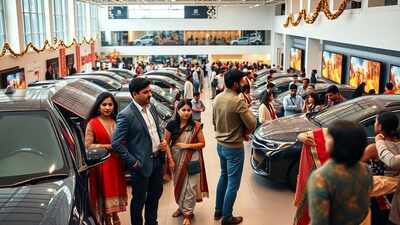
This Navratri, rural India is spending more on cars, motorcycles, televisions, beauty products, and premium watches, with several categories outpacing pre-GST sales figures.The trend signals a strong revival in entry-level demand following the overhaul of the goods and services tax (GST).
More vehicles sold in rural India
Automakers like Maruti Suzuki, Hyundai and Tata Motors have reported major spikes in car bookings with sales growing 100-133% as compared to the period before GST 2.0 rollout.
Maruti’s rural bookings have doubled, with Partho Banerjee, senior executive officer, marketing and sales, saying, “beyond top 100 cities, we are seeing booking growth close to 100%.”Nationally, the company has seen a 35% rise in bookings.Tata Motors has also reported rising rural sales, with bookings doubling post-GST cuts. Amit Kamat, chief commercial officer, said, “The festive season, coupled with pent-up demand and the recent GST rate cut, has fuelled strong momentum across rural markets for us.”“Our booking rate has doubled post the new price announcement…with festive sentiment rising, we anticipate retail momentum to strengthen further in the coming days.”Hyundai Motor India also highlighted record rural demand. “We have witnessed a sharp surge in customer interest and demand across rural India,” said Tarun Garg, whole-time director and COO.“During September 22-25, bookings from rural markets rose nearly 133% compared with the pre-reform period (September 1-21).” The company saw a 1.5-fold rise in enquiries in the first four days of Navratri, with rural bookings doubling year-on-year.Tractors are also in high demand, with September sales expected to jump 30–40% despite limited dispatches early in the month, buoyed by healthy harvests and strong monsoons. Experts say the rise in rural affordability, coupled with favourable crop prices, is driving consumer confidence. Though dispatches were on hold in the first three weeks of the month, robust billings were recorded in the last five days, according to industry estimates cited by ET.Bookings for two wheelers too, recorded a rise. Two-wheeler sales, sluggish earlier in the year, are picking up after GST-related price reductions.Hero MotoCorp’s Ashutosh Varma, chief business officer, said, “You have seen good monsoons, reservoirs are full, no extensive damage anywhere, barring one or two places, tractors are growing strongly.”“Every time tractors do well, you have seen two wheelers doing well. We are very confident that this will be one of the best (festive seasons),” he further told ET.Rural demand now accounts for roughly 55% of two-wheeler sales, and industry executives expect 7% growth in FY26 following the tax reset. Limited stocks mean buyers need to act quickly to secure deliveries during the preferred mahurat (auspicious period).Effective September 22, the government cut GST on small cars, under 4 metres, with petrol/CNG/LPG engines up to 1,200cc and diesel up to 1,500cc, from 29–31% to 18%.This move gives buyers net savings of 8.5–9.9%, and when combined with festive offers and promotions, overall price benefits on passenger vehicles have reached a record 12–15%.
Smaller towns dominating online shopping
E-commerce is seeing smaller towns outpacing metros in festive sales. Amazon and Flipkart report that rural TV sales have doubled, thanks to attractive online discounts.“Consumers in smaller towns and rural India will not get such lucrative pricing in stores,” said Avneet Singh Marwah, CEO of Super Plastronics, which sells TVs under Kodak, Thomson and Blaupunkt.“Hence, even absolute sales are more in tier II-IV markets than metros and tier I cities.”Electronics and premium products are also booming. Amazon reports double-digit growth in rural smartphone sales above Rs 20,000 (up 50%), QLED TVs (+23%), mini-LED TVs (+27%), lab-grown diamonds (+10 times), South Korean beauty products (+3 times) and premium watches (+1.5–2 times).The government cut GST on small cars (under 4 metres, petrol/CNG/LPG up to 1,200cc, diesel up to 1,500cc) from 29–31% to 18% on September 22. Buyers now enjoy net savings of 8.5–9.9%, with festive offers and schemes boosting total price benefits to 12–15%.With the festival season in full swing, strong rural demand, better affordability and attractive deals, this Navratri has turned into one of the most promising sales periods in recent years.
GST 2.0 boosts rural consumer’s confidence
Industry executives told ET that rural buyers are feeling more confident, thanks to GST rate cuts, strong monsoons, higher crop prices, and increased sowing activity.Smaller towns are leading the surge in e-commerce growth, according to Amazon and Flipkart data, as both platforms run festive sales. Online TV sales in these areas have even doubled compared with urban markets this Navratri season.Varma further told ET that rural demand is expected to soar as the festive season draws near and harvesting gets over. He further added that rural markets account for 55% of sales.An industry executive said, “there is an awareness among rural consumers that in addition to tax cuts, there are attractive festive offers.”“However, stocks are limited because of limited dispatches in September. If they do not make purchases or bookings right now, they will not be able to take deliveries in their preferred mahurat (auspicious period).”With Dussehra just around the corner, apparel sales have also improved, Lalit Agarwal, managing director of V-Mart Retail told ET. “However, we need to monitor as the excitement is more for large-ticket items like electronics rather than fashion,” he said.







